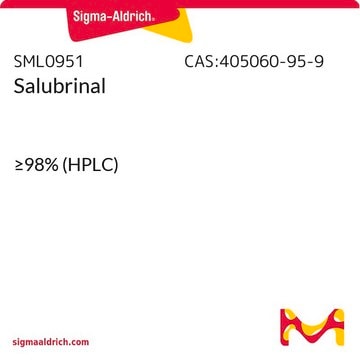Fontos dokumentumok
SML1287
Tunicamycin
from Streptomyces sp., ≥98% (HPLC), DMSO solution, N-acetylglucosamine transferase inhibitor
About This Item
Javasolt termékek
Terméknév
Tunicamycin Ready Made Solution, 5 mg/mL in DMSO, from Streptomyces sp.
biológiai forrás
Streptomyces sp.
Minőségi szint
Forma
DMSO solution
koncentráció
5 mg/mL in DMSO
tárolási hőmérséklet
2-8°C
SMILES string
N4(C=CC(=O)NC4=O)[C@@H]1O[C@@H]([C@H]([C@H]1O)O)C(O)C[C@H]2O[C@@H]([C@@H]([C@H]([C@H]2O)O)NC(=O)\C=C\CC(C)C)O[C@H]3O[C@@H]([C@H]([C@@H]([C@H]3NC(=O)C)O)O)CO
InChI
1S/C30H46N4O16/c1-11(2)5-4-6-16(38)32-19-23(43)20(40)14(47-29(19)50-28-18(31-12(3)36)22(42)21(41)15(10-35)48-28)9-13(37)26-24(44)25(45)27(49-26)34-8-7-17(39)33-30(34)46/h4,6-8,11,13-15,18-29,35,37,40-45H,5,9-10H2,1-3H3,(H,31,36)(H,32,38)(H,33,39,46)/b6-4+/t13?,14-,15-,18-,19-,20+,21-,22-,23-,24+,25-,26-,27-,28-,29-/m1/s1
Nemzetközi kémiai azonosító kulcs
ZHSGGJXRNHWHRS-PEALBESXSA-N
Általános leírás
Alkalmazás
Biokémiai/fiziológiai hatások
Tárolási osztály kódja
10 - Combustible liquids
WGK
WGK 1
Lobbanási pont (F)
188.6 °F
Lobbanási pont (C)
87 °C
Válasszon a legfrissebb verziók közül:
Analitikai tanúsítványok (COA)
Nem találja a megfelelő verziót?
Ha egy adott verzióra van szüksége, a tétel- vagy cikkszám alapján rákereshet egy adott tanúsítványra.
Már rendelkezik ezzel a termékkel?
Az Ön által nemrégiben megvásárolt termékekre vonatkozó dokumentumokat a Dokumentumtárban találja.
Az ügyfelek ezeket is megtekintették
Tudóscsoportunk valamennyi kutatási területen rendelkezik tapasztalattal, beleértve az élettudományt, az anyagtudományt, a kémiai szintézist, a kromatográfiát, az analitikát és még sok más területet.
Lépjen kapcsolatba a szaktanácsadással








